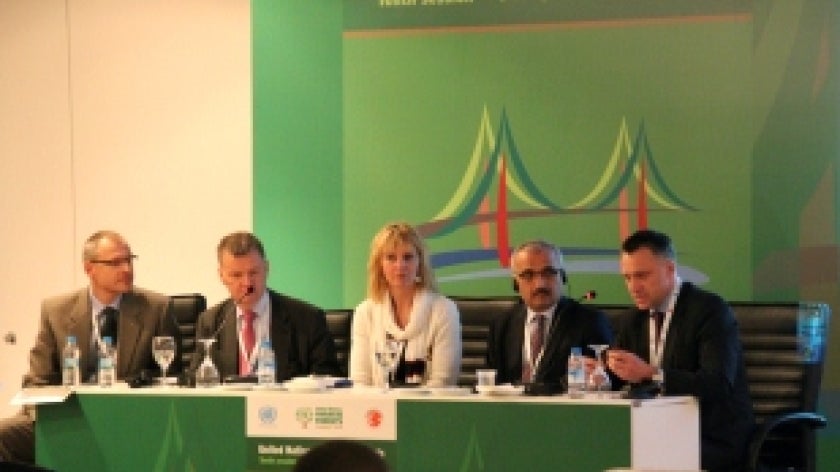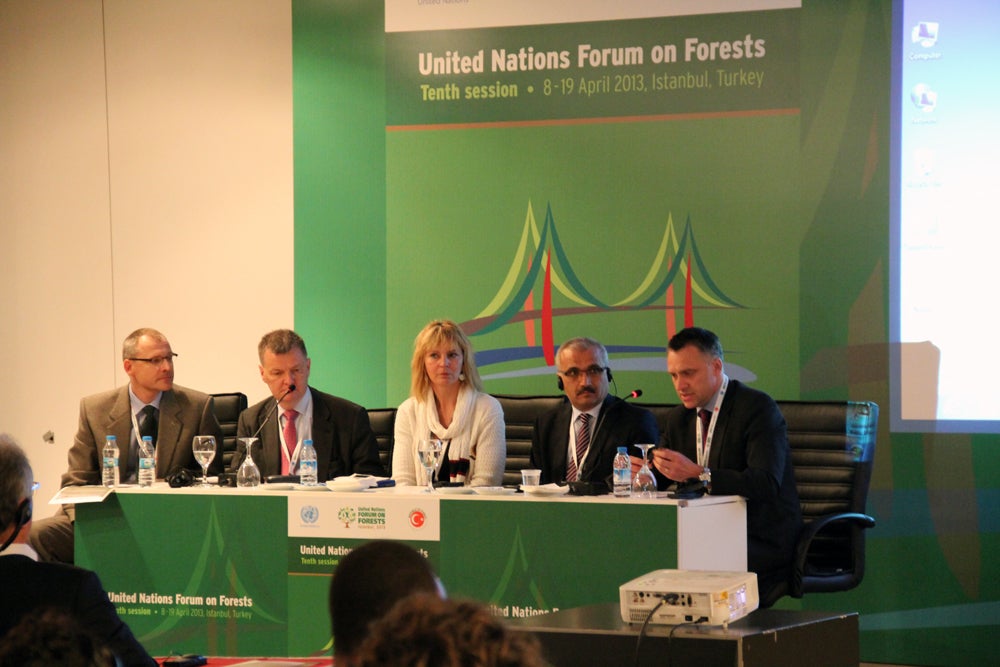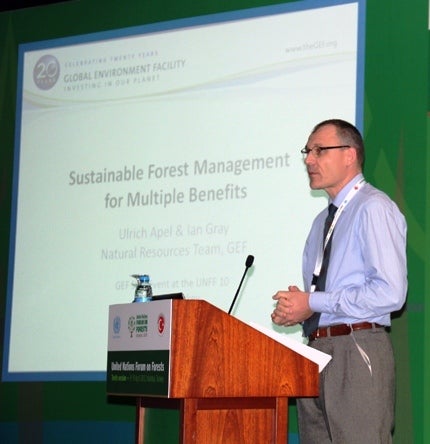

Panel at the GEF side event, from left to right: Ulrich Apel, Senior Environmental Specialist, GEFSEC; Tuukka Castren, Senior Forestry Specialist, World Bank; Ivonne Higuero, Programme Coordinator, Regional Office for Europe, UNEP; Rustem Kiris, Director, Forest Planning and Management Department, General Directorate of Forests, Turkey; Ian Gray, Senior Forest Specialist, GEFSEC
Istanbul, April 16, 2013 – Forests deliver multiple benefits to the global environment, including providing habitat for biodiversity, sequestration of carbon, and human health and economic wellbeing. The challenge confronting the Global Environment Facility and its partners is to find new ways to deliver these benefits and to achieve broader and more meaningful impact on these vital and varied forest ecosystems. Representatives of the GEF addressed those challenges at the 10th session of the United Nations Forum on Forests (UNFF10).
“The challenge of development can only be achieved through integrated action on economic development, social inclusion and environmental sustainability. Forests have to be at the heart of this concept,” Dr. Naoko Ishii, CEO and Chairperson of the GEF, said in an address at UNFF10 this week. “The GEF is uniquely positioned to capture synergy among three Rio conventions, produce multiple benefits from forests, and play a catalytic role for forest financing.”
A UNFF10 side event today, which drew some 100 participants, provided a forum for further discussion, including a presentation by the GEF of its innovative program on sustainable forest management to delegates. Joining the GEF in the discussion about the multiple benefits that forests provide were experts of United Nations Development Programme, the World Bank, and representatives of the host Turkish Government. The benefits forests provide can overlap, but knowing where that happens and under what conditions requires taking a broad view.
Forests are natural capital assets that are vital in sustaining the global environment. Forests provide a wide range of goods and ecosystem services, such as food, wood, fiber, water catchment protection, climate regulation, biological diversity, spiritual fulfillment and aesthetic enjoyment. People depend on these goods and services, yet over the past 50 years humans have altered forest ecosystems more rapidly and extensively than in any other historical period.

The GEF’s experience supporting forest programs makes clear the importance of innovative projects to take advantage of opportunities and also of working collaboratively with Governments and other donors to maximize impact and ensure long-term support for forest projects. GEF-funded projects span a wide range of activities and issues including policy change, land tenure conflicts, and rural livelihoods development.
Using the flexibility and synergies of a multi-focal-area program, the GEF’s fifth funding replenishment cycle – GEF-5 – from July 2010 through June 2014, has established a separate funding window of $250 million operated as an incentive mechanism for countries to enhance financing of their forests. With a goal of encouraging $1 billion in investment in forests through integrated approaches, this strategy focuses the forest-related objectives of three focal areas; biodiversity, climate change and land degradation.
This model reinforces the GEF’s unique position in forest financing globally, drawing from the following:
- Mandate from the three Rio Conventions covering the full range of SFM and REDD+ activities;
- Applicability to all types of forest within 144 developing countries;
- Response to call by the UNFF for dedicated support to SFM;
- Seeks synergy through strengthening cross-cutting themes and avoids silos in forest funding; and,
- Ability to direct significant funding to individual countries from within GEF funds and supported by co-finance from other sources.
These programs and projects have utilized approximately 40% of the $250 million incentive envelope. The GEF-5 investments in forests have leveraged $3.7 billion in co-finance from a range of other sources. This equates to a co-financing ratio of 1:8, which is almost 50% higher than the historical levels of co-finance for GEF-funded forest projects over the past 20 years.